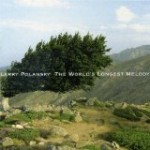music of Larry Polansky
various artists
New World Records
- Ensembles of Note
- tooaytood 1, 2, 3, 5, 6, 7, 9, and 11
- for jim, ben and lou
- “…getting rid of the glue…”
- ivtoo
- The World’s Longest Melody
- Ontslaan (toontood)
- toovviivfor
- 34 Chords (Christian Wolff in Hanover and Royalton)
Various aspects of Larry Polansky’s music are given compelling and nuanced performances on this disc. The opening Ensembles of Note is a funky, rhythmic, semi-controlled improvisation based on a four bar rhythmic germ. When I first heard the disc, I really enjoyed the piece. It is quirky, it grooves, and the formal flow is natural and fluid (a gradual increase in the amount of activity). To my surprise upon reading the notes, the melodic materials are entirely improvised and only the rhythmic ostinato is given. Suddenly, my opinion of the piece and the performance skyrocketed. The ensemble has a wonderfully cohesive feel in their sound as well as to the shape of the piece. The music belongs to the performers as much as it belongs to Polansky and I think that is the right balance for a work that relies so heavily on improvisation.
The tooaytoods are all miniature miniatures (the longest being :24). Originally solo piano works, here they are electric guitar duets. Each tooaytood has its own internal logic, however brief, and each work as perfectly chiseled gems. Could they be developed into longer works? I guess so but I think that would crush their ephemeral beauty and wit.
My favorite composition on the disc is the trio for jim, ben, and lou for guitar, harp, and percussion. Each movement honors a composer important to Polansky’s compositional language (James Tenney, Ben Johnston, and Lou Harrison). Microtonality abounds in the trio and Polansky’s touch with this tonal palette is delicate, expressive, and extremely artful. No note, no matter the clash with other notes, sounds “wrong.” The reverence for these three composers is communicated at a very fundamental level in this trio. Just to contradict myself, the trio has a very light touch, too. Simple formal structures, such as variation, are masterfully used. I’ve been listening to this piece a lot in the last few weeks. A lot.
The brief guitar solo “…getting rid of the glue…” is in some ways a flashback to how Polansky arrived at the style of these previous, yet more recent, pieces. Sparse pointallistic gestures create a timeless and directionless space. Harmonics, gentle humming, and detuned strings pass through this space created by the work. The next track, ivtoo, then sounds like the direct descendent of “…getting rid of the glue…” and the trio. Toon Callier’s overdubbed acoustic guitars form a cloud of active-yet-directionless harmonies and colors. It is as if a pizzicato fog has descended. The directionlessness is merely an illusion, of course, as the piece slowly and inexorably oozes into more tense and strenuous areas.
The ensemble version of The World’s Longest Melody (also the title of the trio movement dedicated to Lou Harrison but is not the same piece) rings in with epic power chords and drums. One might expect a power rock thrash will emerge but the piece stays fairly tame if that is your expectation. There is a cyclic and periodic repetition of ideas, a non-Western-inspired sense of form, that again has its own compelling logic. Similar temporal logic gets merged with Western harmonies in the next tracks Ontslaan (toontood) and toovviivfor. In Ontslaan (toontood) a very stock sounding chorale of electric guitars quickly gets warped and bent and twisted until almost beyond recognition (keyword: almost). toovviivfor uses a decidedly less comfortable and more abstract harmonic grounding and then proceeds in a similar manner.
Polansky’s musical language is naturally complemented by the guitar. The timbre works well to provide a clarity to his pitch/temperament choices and the resonance (or sustain in the case of the electric guitars) works well to enforce the mood or emotional tone of the pieces. The final track, 34 Chords (Chrisitan Wolff in Hanover and Royalton) is another reverent homage that exploits these facets of the electric guitar to great effect (and affect).




















